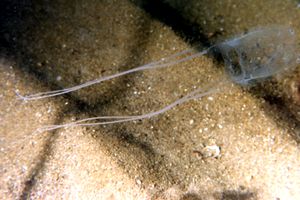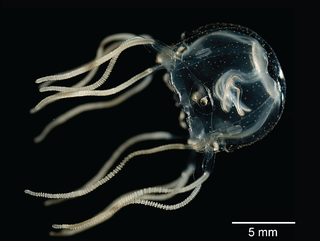
Cnidaria is a phylum under kingdom Animalia containing over 11,000 species of aquatic animals found both in freshwater and marine environments, including jellyfish, hydroids, sea anemone, corals and some of the smallest marine parasites. Their distinguishing features are a decentralized nervous system distributed throughout a gelatinous body and the presence of cnidocytes or cnidoblasts, specialized cells with ejectable flagella used mainly for envenomation and capturing prey. Their bodies consist of mesoglea, a non-living jelly-like substance, sandwiched between two layers of epithelium that are mostly one cell thick.

Box jellyfish are cnidarian invertebrates distinguished by their box-like body. Some species of box jellyfish produce potent venom delivered by contact with their tentacles. Stings from some species, including Chironex fleckeri, Carukia barnesi, Malo kingi, and a few others, are extremely painful and often fatal to humans.

Carybdea is a genus of venomous box jellyfish within the family Carybdeidae that currently consists of a total of 8 species. This genus of jellyfish are often found in warm waters around the world in waters such as the Mediterranean Sea, the Pacific Ocean, and off the coast of Africa. Their sting can cause a range of effects depending on the species. These invertebrates will go through both sexual and asexual reproduction as they transform from a polyp to medusa. Carybdea have a box-shaped bell with four tentacles and eye-like sensory structures. There are distinct physical markings that differentiate many species within the genus. While Carybdea use their venom to act as predators, they are also preyed on by turtles and various fish. They feed on plankton, invertebrates, fish, and some crustaceans.

Chirodropidae is a family of venomous box jellyfish within the class Cubozoa. Like other members of the order Chirodropida, they have branched pedalia, in contrast to the unbranched pedalia of box jellyfish in the order Carybdeida. Each branch houses its own individual tentacle. Nematocyst composition and type can vary among individuals within this family based on body size and life stage. Like other box jellyfish, chirodropids can be found in coastal and shallow marine areas, but they have also been found to occur at benthic depths.

Alatina alata(Reynaud, 1830), often called a sea wasp, is a species of box jellyfish found in the Pacific, Indian and Atlantic Oceans and in the Caribbean and Arabian Sea.

Atolla is a genus of crown jellyfish in the order Coronatae. The genus Atolla was originally proposed by Haeckel in 1880 and elevated to the monotypic family level, as Atollidae by Henry Bigelow in 1913. The six known species inhabit the mesopelagic zone. The medusae possess multiple lobes called lappets at the bell margin. Medusae also have eight tentacles, alternating with eight rhopalia, and twice as many lappets occur as tentacles.

Malo is one a genus of box jellies in the family Carybdeida in the Phylum Cnidaria. It has four known species, three of which were described by the Australian marine biologist Lisa-Ann Gershwin. The genus was discovered in 2005. Many of the species are known for their paralytic and deadly affect. Many species in the Malo genus are very small and hard to capture and study. Many species of Malo have been captured on the Western and Eastern cost of Australia. Malo appear to be solidarity jellies.

Carybdeida is an order of box jellyfish. There are five families within the order. They are distinguished from other box jellyfish by the presence of unbranched muscular bases at the corners of the cubic umbrella. Most species have four tentacles.

Cyanea is a genus of jellyfish, primarily found in northern waters of the Atlantic and Pacific Oceans and southern Pacific waters of Australia and New Zealand, there are also several boreal, polar, tropical and sub-tropical species. Commonly found in and associated with rivers and fjords. The same genus name has been given to a genus of plants of the Hawaiian lobelioids, an example of a parahomonym.
Calvadosia cruxmelitensis is a stalked jellyfish which inhabits the intertidal and sublittoral zones of rocky coasts in south-western England and the Atlantic coast of Ireland.

Carukiidae is a family of box jellyfish within the Cubozoa class. Carukiidae can be easily classified by their lack of cirri clumps inside the cubozoan stomach, as well as the size and the placement of their nematocysts.

Limnomedusae is an order of hydrozoans.

Olindiidae is a family of hydrozoans in the order Limnomedusae. They have a polyp phase and a medusa phase. The polyps are generally small (1 mm) and solitary, but a few species are colonial. They have a varying number of tentacles and can reproduce by budding. In the largest species, the medusae can grow to 15 cm (6 in). Centripetal canals may be present or absent and the radial canals are unbranched. The gonads are beside the radial canals, except in Limnocnida, where they are on the manubrium. The fertilised eggs develop into planula larvae which become polyps. These multiply asexually or can bud off medusae. In some species, medusae are only produced when the water temperature exceeds a certain level. Most species are marine, but several can also be found in brackish water and a few, notably Craspedacusta and Limnocnida, are found in fresh water.

Carybdea murrayana Haeckel, 1880, also previously known as Carybdea branchi, the South African box jellyfish, is a venomous species of cnidarian, in the small family Carybdeidae within the class Cubozoa.

Alatina is a genus of box jellyfish within class Cubozoa. It is the largest of the three known genera in the family Alatinidae, and the only one which is not monotypic. It contains the following ten species:
Chiropsella bronzie is a species of box jellyfish. It is considered much less of a threat to humans than some of its relatives. The species was described in 2006, and is one of four species in the genus Chiropsella. Chiropsella bronzie can be found in shallow waters off the coast of Queensland, Australia.

Alatina grandis is a species of box jellyfish in the genus Alatina. It has been found in the Pacific Ocean off the coasts of islands in French Polynesia.

Atorella vanhoeffeni, also known as the gold-spotted crown jelly, is a species of true jellyfish in the family Atorellidae.
Nausithoe picta is a species of crown jellyfish in the family Nausithoidae. It is found in the south Pacific Ocean.















